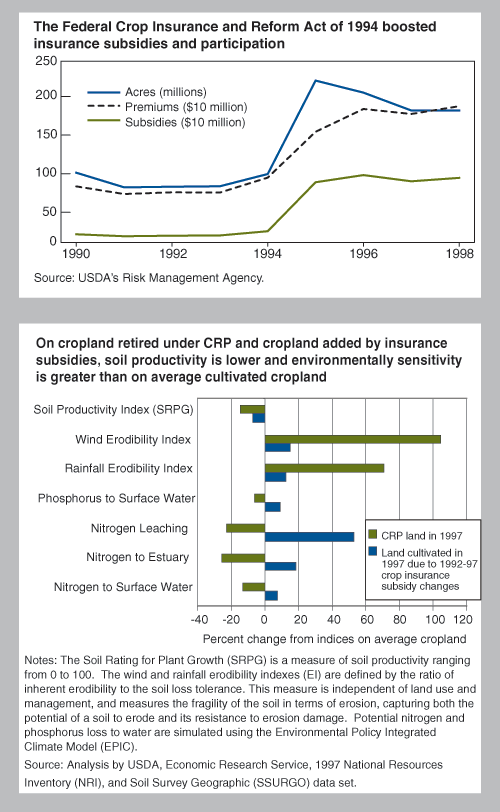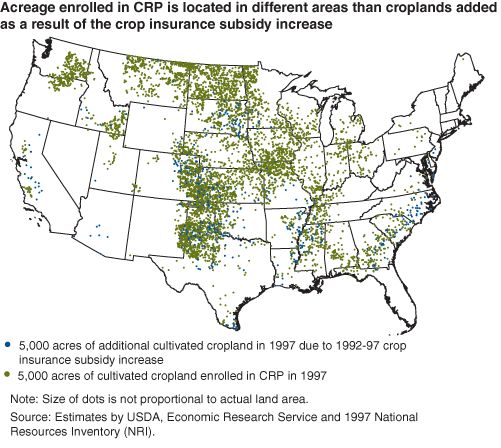Agricultural Policy Affects Land Use and the Environment
- by Ruben N. Lubowski, Roger Claassen and Michael J. Roberts
- 9/1/2006
Highlights
- Economic conditions and policy changes encourage producers to shift less productive, or “marginal,” cropland in and out of production.
- Because marginal lands are also more environmentally sensitive than highly productive land along several dimensions, cropland shifts have environmental, as well as economic, effects.
- Thus, agricultural and conservation programs that affect land use likely have greater effects on erosion and some other environmental factors than on production.
While total U.S. cropland acreage has remained roughly constant for 100 years, relatively large amounts of less productive, or “marginal,” cropland have shifted in and out of production over time. Almost three-quarters of the cropland acreage that shifted into or out of cultivation between 1982 and 1997 had soil productivity below that of the average acre of cropland. Economic forces, such as changing commodity prices or production costs, are likely to induce farmers to shift marginal land in and out of production, while farmers will tend to keep highly productive cropland in cultivation. ERS research shows that, in general, low-productivity croplands are more environmentally sensitive than high-productivity land along several dimensions, including wind and water erosion and potential nutrient losses to water. Therefore, land-use changes on less productive cropland may have unanticipated environmental consequences.
Agricultural and conservation policies also influence land-use decisions. Land retirement programs directly affect land use, while other agricultural policies may change the economic incentives to cultivate crops. Two very different types of policies—the Conservation Reserve Program (CRP) and the Federal Crop Insurance Program—illustrate how policies can affect land use on lower quality and environmentally sensitive cropland. These government programs that affect land use may have as significant an effect on the environment as on production, and the specific environmental impacts will vary with the features of each program.
The CRP Provides Environmental Benefits by Retiring Marginal Lands
The Conservation Reserve Program is a land retirement program that offers payments to farmers to reduce cropland acreage for environmental gains. The program has been an important driver of changes in cropland since 1985. The CRP uses a competitive bidding process with selection criteria that target highly erodible land, among other environmental factors. This gives farmers the incentive to offer their less economically productive acreage, and, by design, the retired land is more environmentally sensitive than average cropland.
In 2005, the CRP paid farmers $1.7 billion to keep a land area almost the size of Iowa out of production. Thus, the CRP directly influences cropland conversion. As long as the program does not affect commodity prices, the land-use effects of the CRP can be largely restricted to those lands participating in the program. An ERS study of land parcels enrolled in the CRP found them to be less productive and more environmentally sensitive in terms of erosion, but not in terms of potential nutrient runoff and leaching, than average cultivated cropland and than other lands shifting out of cultivation. These patterns in environmental sensitivity for CRP and non-CRP land held even within the same crop reporting district (multicounty areas within States).
Federal Crop Insurance Subsidies May Encourage Cultivation of Marginal Lands
Although crop insurance participation does not involve a direct land-use conversion, unintended acreage and production impacts may occur. The Federal Crop Insurance Program raises incentives to grow crops. A longstanding concern is that the program may maintain or increase crop cultivation in frequently flooded and other risky areas containing wetlands and other environmentally sensitive lands.
Farmers weigh three main factors when deciding whether to purchase weather-related crop insurance: their estimated probability that a weather-related event will occur; the amount of loss that will be indemnified (never 100 percent); and the premium they must pay. They will tend to choose to insure if their perceived loss is less with insurance than without insurance. The Federal Crop Insurance Program subsidizes part of the premium for farmers, which increases their incentive to participate.
In the early 1990s, the high cost of insurance premiums discouraged participation in the program. In 1994, following the devastating floods of 1993, Congress passed the Federal Crop Insurance and Reform Act, increasing premium subsidies for all crop insurance products, while adding catastrophic coverage and revenue insurance options. The premium subsidies were increased significantly to encourage more producers to participate.
Further subsidy increases were enacted by Congress in 1999-2000. Crop insurance participation increased with the growth in subsidies. Insured acreage more than doubled from 90 million acres to 197 million acres between 1990-94 and 1995-99, and then rose to an average of 212 million over 2000-03. That is about 60 percent of cultivated cropland in the 48 contiguous States.
ERS researchers studied the period of increased enrollment after the 1994 Crop Insurance Act to observe how land use responded. Insurance program changes increased cropland in production by an estimated 1 percent in 1997. But effects of these changes appear to have been largest on low-quality and certain environmentally sensitive lands. An ERS model was used to estimate the acreage that had been brought into or kept in cultivation due to the increases in insurance subsidies, and, on that acreage, soil productivity was below that of average cropland. While 25 percent of all cultivated cropland was classified as highly erodible in 1997, an estimated 33 percent of acreage added to cultivation during the period after the increased insurance subsidies was highly erodible land.
ERS research found that lands brought into or kept in cultivation due to changes in the crop insurance program were slightly more prone to frequent flooding and were more likely to include previously cropped wetlands and environmentally sensitive ecosystems than average cultivated cropland. Total wetlands in cultivation as a result of the 1992-97 subsidy increase are estimated at 37,000 acres, 0.7 percent of the 5.4 million acres of wetlands under crop cultivation. But the affected wetlands represent about a fifth of the net loss (163,000 acres) in non-Federal wetland area between 1992 and 1997.
Impacts Are Not the Same Across Programs
Crop insurance subsidies are also estimated to increase cultivation in areas subject to high levels of nutrient loss. While nutrient loss estimates take into account land erodibility, they may not accurately reflect differences in fertilizer applications on less productive lands. These lands in cultivation due to insurance subsidy changes are estimated to have higher potential phosphorus leaching and nitrogen loss to groundwater, surface water, and estuaries than do average cultivated croplands. In contrast, cropland enrolled in CRP tends to have below-average levels of potential nitrogen and phosphorus losses, possibly because the program tends to attract lands from arid regions where factors driving nutrient loss—rainfall runoff and rainfall-based soil erosion—are less intense. Once CRP acreage is removed from cultivation and the approved ground cover is established, nutrient transport from the land would be even less.
Acreage enrolled in CRP is located in different geographic areas than croplands brought into cultivation after the 1994 increase in crop insurance subsidies. Lands brought into or retained in cultivation due to the increased subsidies are clustered in certain regions (Prairie Gateway, Mississippi Portal, and Eastern Seaboard). The Heartland (Illinois, Indiana, Iowa, Missouri, and Ohio) has extensive cropland and a fair amount of land shifting in and out of cultivated crops. This region, however, has relatively few CRP acres (except for a cluster in Iowa and northern Missouri), and the ERS study showed virtually no increase in cultivated area in the region due to higher crop insurance subsidies. (The ERS study accounts for the fact that the level of participation in the crop insurance program was already high in the Heartland, with less potential for an increase than in regions with historically low participation levels.)
Land going into cultivation due to higher crop insurance subsidies was estimated to include areas with large populations of wildlife species classified in NatureServe’s Natural Heritage database as imperiled. In particular, the cluster of land shifting into production in the Plains States coincides with an area of high CRP enrollment and high counts of imperiled bird species. Areas of subsidy-induced cultivation along the Mississippi River and Eastern Seaboard overlap with habitats of fish and mollusk species that are imperiled. ERS land-use models estimate that lands in cultivation due to the crop insurance subsidy increases are located in watersheds with higher counts of imperiled wildlife than average cropland. CRP lands lie in areas with higher counts of imperiled birds (protecting habitat, particularly for birds, is an express CRP objective). While ERS research suggests there are real changes in land use due to these policies, available data are insufficient to determine whether observed or predicted land-use changes have an impact (positive or negative) on imperiled wildlife populations.
Policies Have Environmental Consequences
Agricultural and conservation policies may affect farmers’ land-use decisions directly or indirectly. These decisions will likely be associated with less economically productive land, and these lands are also likely to be more environmentally sensitive along several dimensions than average cropland.
Programs such as crop insurance can have unintended environmental consequences, but crop insurance only affects land use on a relatively small amount of acreage compared with land intentionally retired by CRP. Which lands are affected also depends on the incentive structure of each program. Further, the environmental effects vary regionally and by environmental medium (such as water, soil, or wildlife habitat).
The examples provided by the CRP and the Federal Crop Insurance Program illustrate these effects, but many other policies also induce land-use changes that have environmental effects. Identifying the economic and environmental features of the lands affected by policy incentives, and recognizing that the economic impact of policy-induced land-use changes could be less than previously anticipated—and the environmental impacts could be more than anticipated—could improve the formulation of future farm programs.
This article is drawn from:
- Lubowski, R.N., Bucholtz, S., Claassen, R., Roberts, M., Cooper, J., Gueorguieva, A. & Johansson, R. (2006). Environmental Effects of Agricultural Land-Use Change: The Role of Economics and Policy. U.S. Department of Agriculture, Economic Research Service. ERR-25.
You may also like:
- Environmental Quality - Policy Instruments for Protecting Environmental Quality. (n.d.). U.S. Department of Agriculture, Economic Research Service.
- Major Land Uses. (n.d.). U.S. Department of Agriculture, Economic Research Service.
- The ERS Briefing Room on Land Use, Value, and Management. (2011). USDA, Economic Research Service.



